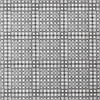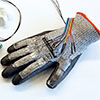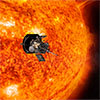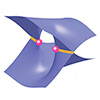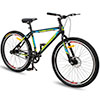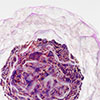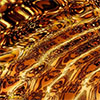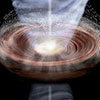Dec 15, 2021 (Nanowerk News) Researchers from the Singapore University of Technology and Design (SUTD) have designed a novel computational model that accurately predicts the properties of photonics materials, paving the way for next-generation photonics devices. Their findings, published in npj Computational Materials ("A scheme for simulating multi-level phase change...
Physicists see an unusual quantum phenomenon
Dec 14, 2021 (Nanowerk News) A highly unusual movement of light emitting particles in atomically-thin semiconductors was experimentally confirmed by scientists from the Würzburg–Dresden Cluster of Excellence ct.qmat–Complexity and Topology in Quantum Matter. Electronic quasiparticles, known as excitons, seemed to move in opposite directions at the same time. Professor Alexey...
Color-sorting metalenses boost imaging sensitivity
Dec 14, 2021 (Nanowerk News) Researchers have shown that newly designed pixel-scale metasurface lenses — flat surfaces that use nanostructures to manipulate light — can be used to make imaging sensors that are roughly three times more sensitive than those used today. The new sensor architecture could enable digital cameras...
Unbreakable bionic glove made from silk for human-machine-interfacing
Dec 14, 2021 (Nanowerk News) DTU researchers have designed the new electronic material CareGum (Advanced Materials, "The Manufacture of Unbreakable Bionics via Multifunctional and Self-Healing Silk–Graphene Hydrogels"). It is highly adaptable and has unique sensing properties. It could enable those who cannot speak to speak again. Also, it allows digital...
Spacecraft enters the Sun’s corona for the first time in history
Dec 14, 2021 (Nanowerk News) A spacecraft launched by NASA has done what was once thought impossible. On April 28, the Parker Solar Probe successfully entered the corona of the Sun — an extreme environment that’s roughly 2 million degrees Fahrenheit. The historic moment was achieved thanks to a large...
Losing isn’t always bad: Gaining topology from loss
Dec 14, 2021 (Nanowerk News) Losing particles can lead to positive, robust effects. An international collaboration has demonstrated a novel topology arising from losses in hybrid light-matter particles, introducing a new avenue to induce the highly-prized effects inherent to conventional topological materials, which can potentially revolutionise electronics. Led by Singapore’s...
Engineers developing ‘smart’ bikes to improve cycling safety, efficiency
Dec 14, 2021 (Nanowerk News) The market for 'smart' cars – vehicles featuring a range of technologies and connectivity solutions featuring geospatial and remote sensing – has grown dramatically in recent years. Manufacturers haven’t yet incorporated these advanced technologies into bicycles on a level widespread enough to make smart bikes...
New white paper describes challenges and potential solutions for 3D cell culture visualization
Dec 14, 2021 (Nanowerk News) During clinical research, cell cultures help test new drugs, determine the correct dosage of active substances, and better understand processes in the human body. Until now, we have mostly used cell cultures growing in a single layer on a culture medium. However, current research results...
Surfing the spin wave in graphene
Dec 14, 2021 (Nanowerk News) Spin waves, a change in electron spin that propagates through a material, could fundamentally change how devices store and carry information. These waves, also known as magnons, don’t scatter or couple with other particles. Under the right conditions, they can even act like a superfluid,...
Stellar ‘ashfall’ could help distant planets grow
Dec 14, 2021 (Nanowerk News) The world’s first 3D simulation simultaneously considering dust motion and growth in a disk around a young star has shown that large dust from the central region can be entrained by and then ejected by gas outflows, and eventually fall back onto the outer regions...



